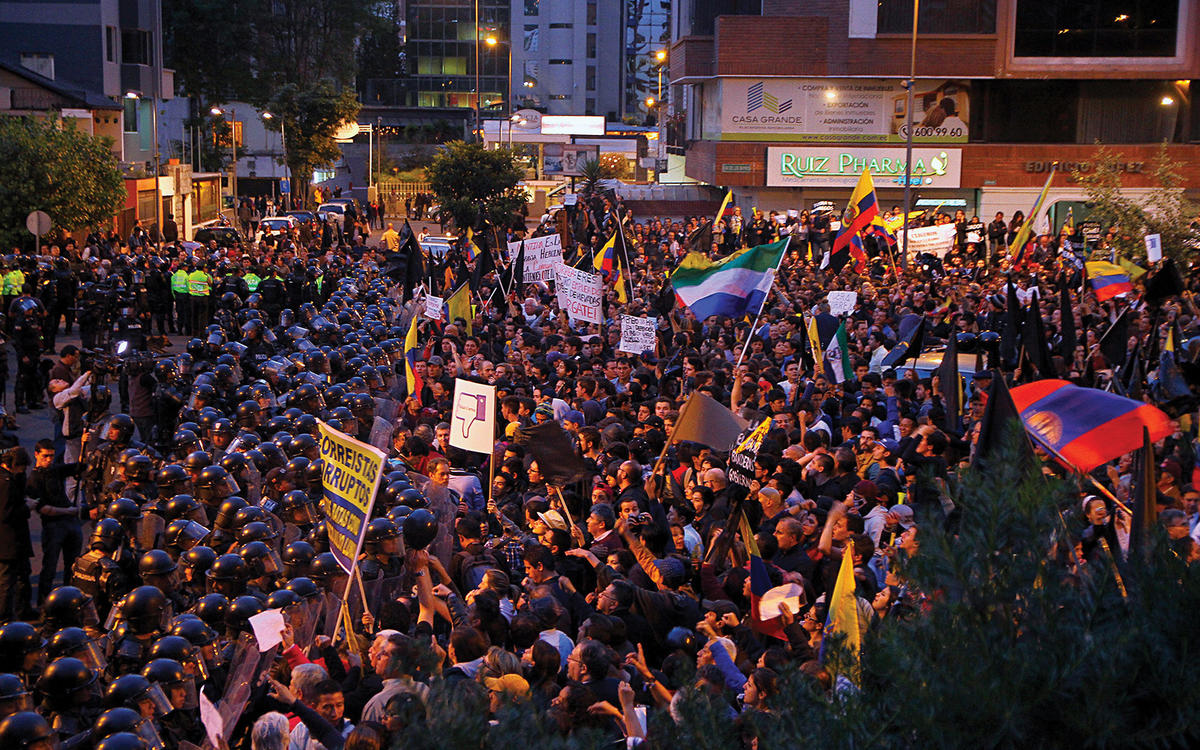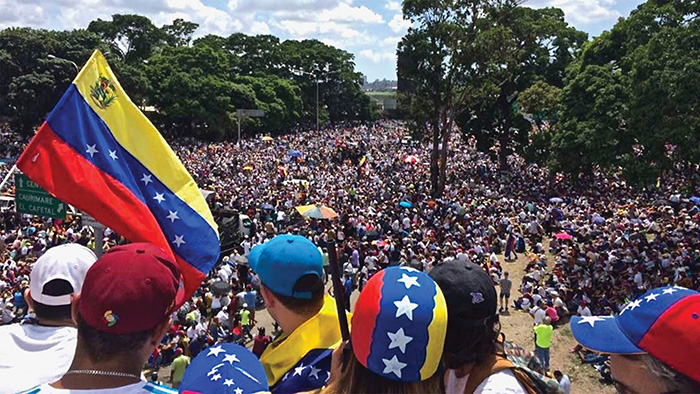Worrisome Trends in Latin America
Widespread corruption, crime and a lack of security, education, employment and basic services are driving a loss of faith in democracy throughout the continent.
BY ALEXANDRIA “ALEXI” PANEHAL

Venezuela’s National Police use tear gas and plastic pellet gunshot against protesting students in Altamira Plaza in Caracas in 2014.
Courtesy of Andres E. Aspurua [CC BY-SA 3.0] / Wikimedia Commons House
The growing repression in Venezuela has dominated U.S. coverage of Latin America and the Caribbean for quite some time, understandably. The intensifying political and economic turmoil under President Nicolas Maduro’s misrule has driven tens of thousands of desperate Venezuelans to Colombia and Brazil—on top of the massive brain drain during Hugo Chavez’s tenure. That exodus, in turn, has precipitated a refugee crisis in Colombia and Brazil; the latter government declared a “social emergency” in February as a result.
The breakdown of law and order in Venezuela reflects a growing perception in the region of citizen insecurity, which can weaken public faith in political institutions and the rule of law.
On the positive side, an incredible three out of every four Latin Americans of voting age either voted in a presidential election last year or will be eligible to do so in 2018. Those two years are packed with a total of nine presidential elections—in Brazil, Chile, Colombia, Costa Rica, Ecuador, Honduras, Mexico, Paraguay and Venezuela—not to mention legislative midterm elections in several countries. The outcomes of that balloting will have major ramifications, positive and negative, for U.S. economic and political interests in Latin America and the Caribbean.
While holding free and fair elections is an important exercise of democratic principles, it is not sufficient. Strengthening the rule of law, inculcating respect for minority and human rights, and increasing citizen satisfaction with government services are also important building blocks in that process. Unfortunately, recent polling data reflect some discouraging trends in those areas. Yet despite some worrisome trends as far as support for democracy in the region is concerned, economic ties between the United States and Latin America remain strong.
The Power of Trade and Investment

A protestor at the national strike in Guatemala in 2015 holds a sign saying "Not my President," referring to then-President Otto Fernando Pérez Molina, who left office on Sept. 2, 2015, and was arrested the following day on charges of corruption.
Nerdoguate [CC BY-SA 4.0] / Wikimedia Commons
The United States continues to be one of the top trading partners for nearly every country in Latin America, so these trends should be of concern in Washington, D.C. According to the U.S. Census Bureau for 2016, America’s top four trading partners in Latin America in terms of exports to the United States were Mexico, Brazil, Colombia and Argentina. Chief exports to the United States from Latin America include oil, agricultural products, minerals and manufactured goods. In terms of exports from the United States to Latin America, sales more than doubled between 2000 and 2013.
To solidify its economic dominance of the region, the United States has signed reciprocal trade agreements with its most important Latin American partners, as well as regional trade agreements like the North American Free Trade Agreement and the Central America and the Dominican Republic Free Trade Agreement. In addition, U.S. foreign direct investment in Latin America is twice as great as it was a decade ago, much of it in Brazil and Mexico.
At the same time, new, influential economic actors have entered the scene. In the last 15 years, China has emerged as a new economic powerhouse in the Americas, and recent Russian economic and political activity in Venezuela is cause for concern. Both of these trends bear watching.
China tends to concentrate its trade and investment in a few key countries—principally Venezuela, Ecuador, Chile, Peru, Mexico and Brazil—that possess natural resources like oil or minerals, which are of particular interest to Chinese investors. Its volume of trade with the Americas as a whole has skyrocketed, from $12 billion in 2000 to more than $260 billion in 2013. Beijing has also stepped up its lending to the region, from $1 billion in 2008 to $37 billion in 2010. Similarly, in 2015, Beijing’s imports from Chile, Peru and Brazil represented 8, 5 and 2.5 percent of each nation’s gross domestic product, respectively.
Chinese and, more recently, Russian involvement in Venezuela warrants special attention. Historically, the United States has maintained substantial investments in Venezuela and conducted considerable trade, primarily in imports and exports of petroleum and its derivatives, with that country. However, the exploitation of new domestic reserves has reduced our dependence on imported oil, while the imposition of sanctions against the Chavez and Maduro regimes, and the growing economic and political turmoil in Venezuela, have curbed the appetite of U.S. investors. Moscow and Beijing have both moved into the resulting vacuum.
Russia’s state-owned oil company, Rosneft, has extended at least $17 billion in loans and credit to Caracas since 2006, giving more than $1 billion in April 2017 alone. On at least two occasions, this influx of Russian cash reportedly kept the Venezuelan government from defaulting on its foreign loans. In exchange, Moscow has been promised future oil shipments, acquired ownership interests in some of Venezuela’s more profitable oil projects and gained greater control over Venezuela’s crude reserves.

In Quito, protestors meet riot police during a demonstration against the policies of then-President Rafael Correa, in particular the inheritance tax laws introduced by his government, in 2015.
Carlos Rodriguez / Andes (flickr) [CC BY-SA 3.0] / Wikimedia Commons
Law and Disorder
In addition to facilitating China and Russia’s inroads into Venezuela, the country’s turmoil has also undermined U.S. and Latin American efforts to combat the drug trade. Narcotraffickers have now shifted some of their operations to Venezuela, where ungoverned spaces and outright collusion with local authorities (including Venezuelan Vice President Tareck Aissami, who is linked to cocaine cartels) facilitate their activities. Because of the influx of drug traffickers, as well as the emergence of paramilitary groups and general lawlessness, Venezuela held the dubious distinction of having the highest murder rate per capita in the world in 2016. But concern over the crime rate extends far beyond Venezuela.
Ask people almost anywhere in Latin America what their key concern is, and many will say crime. Fueled by widespread trafficking in drugs, weapons and people, as well as poverty and gangs, Latin America has become one of the most violent places on earth. In 2013, nearly one in every three murders in the world took place on the streets of Latin America—where just 8 percent of the world’s population lives. The United Nations Office on Drugs and Crime’s “Global Study on Homicide 2013,” which examined peacetime murder statistics from all over the world, ranked 13 Latin American countries among the top 20 most dangerous in the world; these included Honduras, Venezuela and Brazil.
Latin American cities are particularly dangerous. According to the World Atlas, in 2017 the top three cities in the world with the highest murder rate per capita were all in Latin America; Los Cabos, Mexico, ranked first, followed by Caracas, Venezuela, and Acapulco, Mexico. In fact, of the top 50 most murderous cities, Latin America accounted for an astounding 90 percent (40 cities). Most of these cities were concentrated in a few countries, notably Brazil, Mexico, Venezuela and Bolivia.
A perception of governmental inability to combat crime is also widespread. The World Justice Project’s 2017 report ranked most Western Hemisphere countries near the bottom on its order and security index, with Venezuela at 110th out of 113 countries worldwide, and Colombia, Bolivia and Guatemala at 105, 101 and 100, respectively.
Fueled by widespread trafficking in drugs, weapons and people, as well as poverty and gangs, Latin America has become one of the most violent places on earth.
The region’s ranking was even worse on the WJP’s Criminal Justice Index, with Honduras, Bolivia and Venezuela scoring as the bottom three. Eleven other Latin American countries, including Ecuador, Colombia and Mexico, fell within the bottom tercile, as well. On the WJP’s Rule of Law Index, Venezuela was again dead last at 113—below Cambodia, Zimbabwe and Afghanistan—while Bolivia and Honduras scored among the worst in the world, at 106 and 103, respectively. The index noted that, compared to 2016, 14 countries in the Americas slipped down, while only 11 improved and five stayed the same.
The apparent inability of these governments to combat crime has provoked two disturbing responses that may not bode well for stability in the region. First, it has provided yet another reason for people to emigrate. Recent surveys by both Vanderbilt University and the Inter-American Dialogue indicate that insecurity and the fear of crime now appear to be one of the most important “push” factors that compel people to emigrate. A significant percentage of migrants from Guatemala, Honduras and El Salvador cited violence—not economic opportunities or family reunification—as their primary motive for entering the United States.
Second, it seems clear that many people in the Americas feel democracy has not delivered on its promises. Job creation, access to quality education, poverty alleviation, citizen security and improvements in the quality of life have not reached enough Latin Americans, especially the poor. Although the World Bank projects that the region’s economies will grow on average by 1.2 percent in 2017 and 2.1 percent in 2018, the growth of the middle class has slowed. Consequently, some 39 percent of Latin Americans are vulnerable to falling back into poverty. And even though the middle class has grown a little, so has inequality. Despite substantial improvements between 2002 and 2014, Latin America still has the highest level of income inequality in the world.
Restoring Faith in Democracy

On May 20, 2017, millions marched in Caracas to mark the 50th consecutive day of protests, demanding an end to repression and immediate elections.
Voice of America / Wikimedia Commons
When governments don’t effectively combat crime, many people conclude that a democratic system can’t protect them. They therefore become more inclined to sacrifice some freedom for more security. Vanderbilt University’s 2017 Latin American Public Opinion Poll reveals that popular support for democracy reached its lowest regional average in 2014 (the last year for which we have comparable data across the region), even as responses favoring “authoritarian stability” and citing “democracy at risk” hit levels not seen in decades. These antidemocratic attitudes were particularly pronounced in Brazil, Haiti, Venezuela, Paraguay and Jamaica.
The Economist Intelligence Unit’s 2017 Democracy Index also showed a broad decline in support for democracy. Of the 24 Latin American countries encompassed in its review, only one, Uruguay, was categorized as a full democracy. Fifteen were branded “flawed” democracies, five were “hybrids” and two—Venezuela and Cuba—were identified as “authoritarian regimes.” All of these studies point to a disturbing decline in support for democratic structures throughout the Americas.
Part of the explanation for this regression from democratic norms can be attributed to rampant corruption. Vanderbilt’s LAPOP surveys have documented that this has a strong, corrosive influence on citizens’ trust in their government. In Latin America, corruption has historically been widespread and deep-seated and impunity commonplace. Still, the unfolding of the Oderbrecht bribery scandal has shocked voters from Brazil to the Dominican Republic, and led to the resignations of Peruvian President Pedro Pablo Kuczynski and Ecuadoran Vice President Jorge Glas, and the latter’s subsequent sentencing to six years in prison. This anticorruption effort, initiated by crusading public prosecutors in Brazil and embraced by suits filed by both public prosecutors and private citizens in other Latin American countries, may reflect an awakening of activism in Latin America to finally try to weed out corruption and impunity.
The World Justice Project ranked the vast majority of Latin American and Caribbean countries in the bottom third in the world in terms of combating corruption. Transparency International’s latest Corruption Perceptions Index also gave these countries an average grade of 44 out of 100 (anything below 50 indicates governments are failing to tackle corruption in their own system).
There are several policy implications for the United States in all that is brewing in the hemisphere. First, helping Latin Americans control their crime wave would not only help stem the flow of illegal drugs into the United States but, based on recent surveys of the push-and-pull factors that influence emigration, it also could dampen the flow of illegal immigration. Second, promoting more effective governance and the rule of law, and helping authorities combat corruption, are both critical to the creation of more stable democracies. The United States is providing these countries with some assistance through the Merida Program, the Caribbean Basin Security Initiative and the Central American Regional Security Initiative to combat drug trafficking and the crimes associated with it, such as money laundering and bribery.
Finally, strengthening our economic ties with the region will help create more jobs there and more reliable trading partners for U.S. businesses. This, in turn, can also dampen the impulse to migrate, reduce the attraction of illegal jobs, and offset the influence of actors such as China and Russia in Latin America. A strong and sustained U.S. presence throughout the hemisphere can also help combat the other nefarious influences that seep across our common borders like trafficking in persons, arms and drugs, as well as, potentially, terrorism.
Our foreign policy focus tends to shift with the latest crisis. In the case of the Americas, as I have tried to underscore in this article, the absence of crises does not imply that all is well. Trouble is brewing in Latin America. We need to remain vigilant to the disturbing trends and maintain our focus on, and commitment to, the region.
The United States and Latin America are inextricably linked by our economies, our shared political principles and security concerns, and the strong bonds between our peoples. Now is not the time to lose sight of all we have to gain, or lose, in Latin America.









